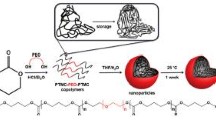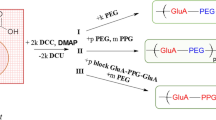Abstract
The modification of surface properties of biodegradable poly(lactide-co-glycolide) (PLGA) and model polystyrene nanospheres by poly(lactide)-poly(ethlene glycol) (PLA:PEG) copolymers has been assessed using a range of in vitro characterization methods followed by in vivo studies of the nanospheres biodistribution after intravenous injection into rats. Coating polymers with PLA:PEG ratio of 2:5 and 3:4 (PEG chains of 5000 and 2000 Da, respectively) were studied. The results reveal the formation of a PLA: PEG coating layer on the particle surface resulting in an increase in the surface hydrophilicity and decrease in the surface charge of the nanospheres. The effects of addition of electrolyte and changes in pH on stability of the nanosphere dispersions confirm that uncoated particles are electrostatically stabilized, while in the presence of the copolymers, steric repulsions are responsible for the stability. The PLA:PEG coating also prevented albumin adsorption onto the colloid surface. The evidence that this effect was observed for the PLA:PEG 3:4 coated nanospheres may indicate that a poly(ethylene glycol) chain of 2000 Da can provide an effective repulsive barrier to albumin adsorption. The in vivo results reveal that coating of PLGA nanospheres with PLA:PEG copolymers can alter the biodistribution in comparison to uncoated PLGA nanospheres. Coating of the model polystyrene nanospheres with PLA:PEG copolymers resulted in an initial high circulation level, but after 3 hours the organ deposition data showed values similar to uncoated polystyrene spheres. The difference in the biological behaviour of coated PLGA and polystyrene nanospheres may suggest a different stability of the adsorbed layers on these two systems. A similar biodistribution pattern of PLA:PEG 3:4 to PEG 2:5 coated particles may indicate that poly(ethylene glycol) chains in the range of 2000 to 5000 can produce a comparable effect on in vivo behaviour.
Similar content being viewed by others
REFERENCES
L. Illum and S. S. Davis. The organ uptake of intravenously administered colloidal particles can be altered using nonionic surfactant (poloxamer 338), FEBS Lett. 167:70–82 (1984).
J. Senior, C. Delgado, D. Fisher, C. Tilcock and G. Gregoriadis. Influence of surface hydrophilicity of liposomes on their interaction with plasma protein and clearance from the circulation: studies with poly(ethylene glycol)-coated vesicles. Biochim. Biophys. Acta, 1062:77–82 (1991).
R. H. Muller, K. H. Walis, S. D. Troster, and J. Kreuter. In vitro characterization of poly(methyl-methacrylate) nanospheres and correlation to their in vivo fate. J. Control. Rel. 20:237–246 (1992).
L. Illum, S. S. Davis, R. H. Muller, E. Mak and P. West. The organ distribution and circulation time of intravenously injected colloidal carriers sterically stabilised with block-copolymer-poloxamine 908. Life Sci. 40:367–374 (1987).
S. M. Moghimi, L. Illum and S. S. Davis. Organ specific targeting of synthetic and natural drug carriers. In: B. R. Jetter (ed.) Homing Mechanisms and Cellular Targeting, Advances in Molecular and Cell Biology, Vol. 9, pp 263–282
I. S. Muir, S. M. Moghimi, L. Illum, S. S. Davis and M. C. Davies. The effect of block copolymeres on the uptake of model microspheres by Kupffer cells—in vitro and in vivo studies. Biochem. Soc. Trans. 19:329S (1991).
C. J. Porter, S. M. Moghimi, L. Illum. and S. S. Davis. The polyoxyethylene/polyoxypropylene block co-polymer Poloxamer-407 selectively redirects intravenously injected microspheres to sinusoidal endothelial cells of rabbit bone marrow. FEBS 305:62–66 (1992).
S. M. Moghimi, I. S. Muir, L. Illum, S. S. Davis, and V. Kolb-Bachofen. Coating particles with a block co-polymer (poloxamine 908) supress opsonization but permits the activity of dysopsonins in the serum. Biochim. Biophys. Acta. 1179:157–165 (1993)
J. B. Kayes and D. A. Rawlins. Adsorption characteristics of certain polyoxethylene-polyoxypropylene block co-polymers on polystyrene latex. Coll. Polym. Sci. 257:622–629 (1979).
L. Illum, L. O. Jacobsen, R. H. Muller, E. Mak and S. S. Davis. Surface characteristics and the interaction of colloidal particles with mouse peritoneal macrophages. Biomaterials 8:113–117 (1987).
L. Illum, P. West, C. Washington, and S. S. Davis. The effect of stabilizing agents on the organ distribution of lipid emulsions. Int. J. Pharm. 54:41–49 (1989).
J. H. Senior. Fate and behaviour of liposomes in vivo: A review of controlling factors. Crit. Rev. Ther. Drug Carrier. Syst. 3: 123–193 (1987).
S. M. Moghimi, C. J. H. Porter, L. Illum, and S. S. Davis. The effect of poloxamer-407 on liposome stability and targeting to bone marrow: comparison with polystyrene microspheres. Int. J. Pharm. 68:121–126 (1991).
A. L. Klibanov, K. Maruyama, V. P. Torcelini, and L. Huang. Activity of amphipathic poly(ethylene glycol) 5000 to prolong the circulation time of liposomes depends on the liposome size and is unfavorable for immunoliposome binding target. FEBS Lett. 268:235–237 (1990).
M. C. Woodle and D. D. Lasic. Sterically stabilized liposomes. Biochem. Biophys. Acta 1113:171–191 (1992).
J. R. Churchill and F. G. Hutchinson. Biodegradable amphipathic copolymers. European Patent Application, 0 092 918, 1983.
J. R. Churchill and F. G. Hutchinson. Biodegradable amphipathic copolymers. European Patent Application 0 166 596, 1986.
G. Spenlehauer, M. Veillard and T. Nerrechia. Pharmaceutical microspheres containing biocompatible and biodegradable surfactants and polymers. PCT Int. Appl. WO 91 15, 193, 1991.
R. Gref, Y. Minamitake, M. T. Perachchia, V. Trubetskoy, A. Milshteyn, J. Sinkule, V. Torchilin and R. Langer. Biodegradable PEG-coated stealth nanospheres. Proceed. Intern. Symp. Control. Rel. Bioact. Mater. 20:131–132 (1993).
S. Stolnik, M. C. Davies, L. Illum, S. S. Davis, M. Bousta and M. Vert. J. Control. Rel. 30:57–67 (1994).
S. J. Douglas, L. Illum, S. S. Davis and J. Kreuter. Particle size and size distribution of poly(butyl-2-cyanoacrylate) nanoparticles. J. Colloid and Interface Sci. 101:149–158 (1984).
H. Z. Cummins and E. R. Pike (eds.) Photon Correlation and Light Beating Spectroscopy, NATO-ASI Series, Plenum Press, New York, 1974.
L. Illum, S. S. Davis, R. H. Muller, E. Mak, and P. West. The organ distribution and circulation time of intravenously injected colloidal carriers sterically stabilised with block-copolymer-poloxamine 908. Life Sci. 40:1553–1560 (1987).
P. D. Scholes, M. C. Davies, L. Illum and S. S. Davis. Radiolabelling of biodegradable microspheres for site specific drug delivery. Proceed. Inter. Symp. Control. Rel. Bioact. Mat. 19:154–155 (1992).
Y. Huh, W. Donaldson and F. J. Johnson. A radiation induced bonding of iodine at the surface of uniform polystyrene particles. Radiation Research 60:42–53 (1974).
H. M. Patel, S. N. Tuzel and B. E. Ryman. Inhibitory effect of cholesterol on the uptake of liposomes by liver and spleen. Biochim. Biophys. Acta. 761:142–151 (1983).
C. G. Golander, J. N. Herron, K. Lim, P. Claesson, P. Stenius and J. D. Andrade. Properties of immobilized PEG films and interacton with proteins: I Experiments and modeling. In J. M. Harris (ed.) Poly(ethylene Glycol) Chemistry: Biotechnical and Biomedical Applications, Plenum Press, 1992, pp. 221–245.
W. R. Gombotz, W. Guanghui, T. A. Horbert and A. S. Hoffman, Protein adsorption to and elution from polyether surfaces. In: J. M. Harris (ed.), Poly(ethylene Glycol) Chemistry: Biotechnical and Biomedical Applications, Plenum Press, New York, 1992, pp. 249–261.
M. E. Norman, P. Williams and L. Illum. Influence of block copolymers on the adsorption of plasma proteins to microspheres. Biomaterials 14:193–202 (1993).
Author information
Authors and Affiliations
Rights and permissions
About this article
Cite this article
Stolnik, S., Dunn, S.E., Garnett, M.C. et al. Surface Modification of Poly(lactide-co-glycolide) Nanospheres by Biodegradable Poly(lactide)-Poly(ethylene glycol) Copolymers. Pharm Res 11, 1800–1808 (1994). https://doi.org/10.1023/A:1018931820564
Issue Date:
DOI: https://doi.org/10.1023/A:1018931820564




